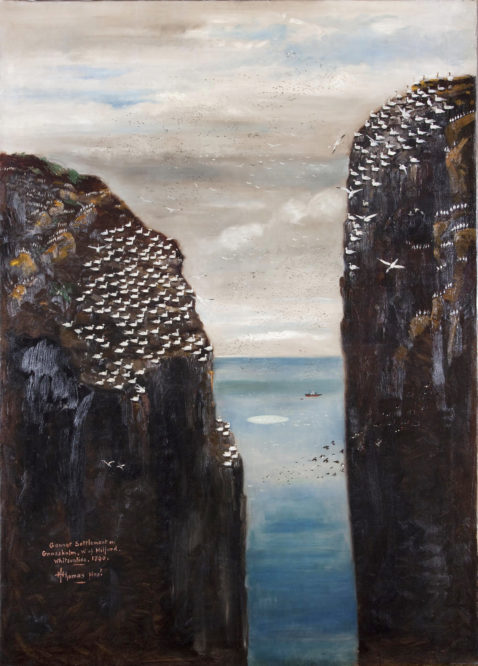The jaunty oil sketch may look charming, but it conceals an ugly story. It was painted by a well-known Cardiff artist, Thomas Henry Thomas, after a visit he and three friends from the Cardiff Naturalists’ Society made to Grassholm (Gwales) on 26 May 1890. They’d come to study the bird colonies, especially northern gannets and puffins. But they were not the only visitors that day.

What happened next has been described in detail in a series of articles on the gannets of Grassholm in nation.cymru by Howell Harris. In brief, a steamer, HMS Sir Richard Fletcher, approached Grassholm. The officers, Royal Engineers from Pembroke Dock, began to amuse themselves by firing their guns at the birds. Even worse, they landed on the island in two boats and began an orgy of destruction, shooting birds and smashing their eggs. By the end only two eggs remained intact, from 200 nests. Thomas called it ‘one of the most brutal scenes I have ever witnessed’.

Killing birds during the nesting season had been a criminal offence since 1869, and Thomas and his friends started a loud campaign, especially through the pages of the Daily Graphic, of which Thomas happened to be the Cardiff correspondent. The paper printed his sketches of the slaughter, and the story spread to other newspapers. The RSPCA became involved, and soon questions were asked in Parliament. One of the dead gannets was stuffed and put on display by the Cardiff Naturalists. Those responsible for the slaughter were prosecuted, but a plea bargain was struck: some charges were dropped and the officers were convicted on just one count, and fined.

Thomas’s painting is a fresh, unVictorian composition, with the gannets scattered across the cliffs on either side of a seaside cleft, and some airborne. At sea, though, HMS Sir Richard Fletcher is nearing the island, and the destruction of the gannets is about to begin. The picture could almost be a prophecy or allegorical warning of the war by humans on the natural world, today more serious than ever.
Since 1890 the gannets of Grassholm have had mixed fortunes. Legal protections for birds were slowly introduced – T.H. Thomas had a hand in framing what became the Wild Birds Protection Act 1894 – but, according to Howell Harris, it was the First World War and the coastal threats posed by German submarines that gave the gannets some respite. Populations recovered slowly in the 1920s; by 1924 there were around 5,000 birds on the island. In 1927 Ronald Lockley came to live on Skokholm and acted as an unofficial warden of Grassholm, discouraging fishermen and visitors from landing on the island. But visitors still arrived, and in the spring of 1930 a fire was started that threatened the gannet colony; Lockley persuaded nearby warships to intervene and douse the flames. It was on Grassholm in 1934 that Lockley made, with Julian Huxley, the first nature documentary film in Britain, The private life of the gannets.

Given the key role that Lockley played in the island’s conservation, it was fitting that Little Toller Books, when they republished his book Dream island (and Island days), reproduced on the cover T.H. Thomas’s painting of the gannets.

Since Lockley’s day – the RSPB bought the island in 1947 – Grassholm has faced new challenges. The Pembrokeshire oil industry was (and remains) a constant source of danger. Marine plastics pollute bird breeding grounds. By 2022, however, the number of nests had increased to more than 34,000 breeding pairs – about 10% of the world population of northern gannets. But then came avian influenza, which cut the number by more than half within one year. That dark, sinister ship in T.H. Thomas’s colourful sketch changes shape with every decade; his successors as protectors of the gannets need all the support they can get.

T.H. Thomas, incidentally, was a multidimensional man. Never simply an artist and illustrator, he was a cultural nationalist and active in all kinds of movements in late Victorian and Edwardian Wales, including the National Eisteddfod, the Royal Cambrian Academy and the campaign to establish a national museum for Wales. He bequeathed over 1,000 prints, drawings and watercolours – many of them unusual in depicting industrial workers – to the National Museum when he died in 1915.

Leave a Reply